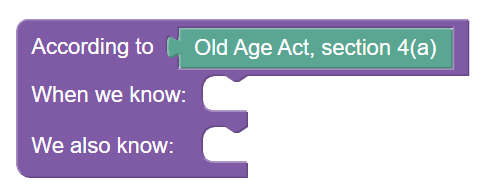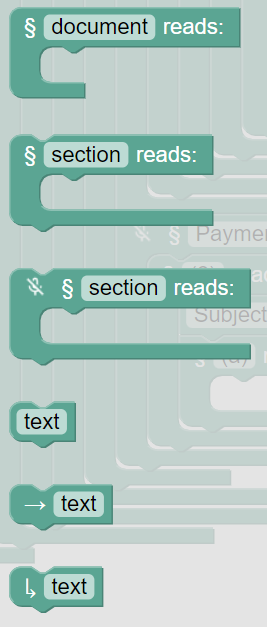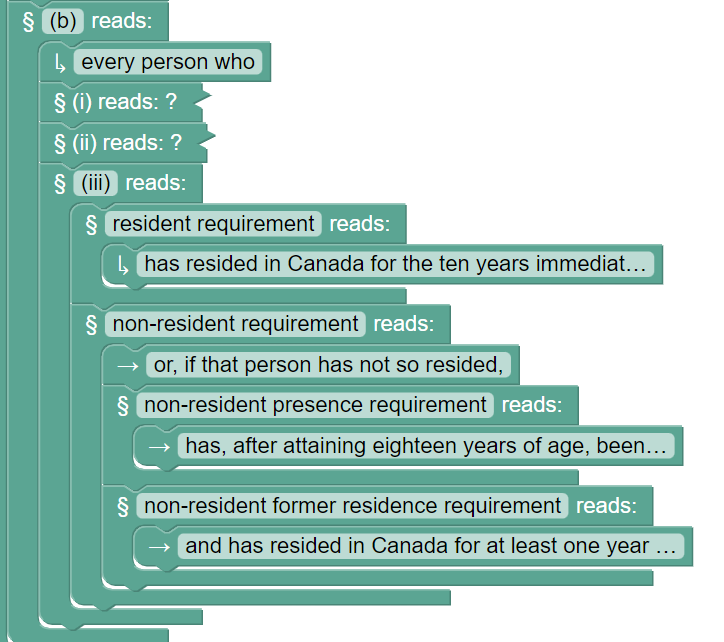Encoding Legal Documents in Blawx
I’ve been spending some time recently working on adding a way to describe legal documents to the development version of Blawx.com.
Objectives
Big picture, I want to have a data structure inside Blawx that is going to allow people to cite the authority for rules using a specific reference, as pictured here:

Importing
The structure should allow the user to add to and modify information imported from a structured source, such as a LegalDocML file.
Minimize Repeated Text
As much as possible, any text that occurs once in a legal document should occur once in the encoded version.
Matching Structure
If the law is divided into parts, divisions, sections, sub-sections, etc., all of those arbitrary divisions should be represented in the encoding, so that it is possible to refer to any subsection.
Intelligent Quoting
If the user refers to a specific sub-part of a legal document, Blawx should be able to tell from the encoding what portions of the text of the document need to be displayed to the user in order for the text of that section to make sense. This requires annotating which sections of text are continuations of which other sections of text.
Intelligent Pin-Point References
Laws are divided into many different types of sub-divisions, but not all of them are always used for pin-point citations. For example, “Act, Section 3(1)(a)” might actually be “Act, Part I, Division 1, Section 3(1)(a)” if you used the full “path”, but we don’t do that. So the system needs to distinguish between path elements that should be used when naming the sections, and those that should not.
Ideally, I want something that is going to automatically generate a tree-shaped structure of pin-point references, each of which can be dereferenced into a useful section of the legal text.
Annotations
Sometimes legislation is not particularly well sub-divided, and a piece of code may refer to only a portion of a long paragraph of text. In those circumstances, I want the user to be able to create their own names for parts of the text, so that they can refer to those parts specifically when specifying the authorities for their code.
KISS
And, of course, the objective is to keep it as simple as possible.
The Current Version
My current version is a set of interface elements that looks like this.

The parts are:
- A root node for a legal document, which can contain any number of the other elements
- A sub-node element with a name that should become part of pin-point references, which can contain any number of any of the non-root elements.
- A sub-node element with a name that should not be part of pin-point references, which can contain any number any of the non-root elements.
- A text element that can be printed without a prefix.
- A text element for text that should be printed with the previous text element.
- A text element for text that should be printed with the text of its parent element.
An Example
It’s still very much a work-in-progress, but here’s an example of what it looked like when I used the current set to encode a portion of the Old Age Security Act:

I feel like if I referred to OAS Act, section 3(1)(b)(iii)(non-resident requirement)
Blawx would be able to tell that section will not make sense without the text that
follows it, and without the text in section 3(1) and the text in section 3(1)(b), so
despite the fact that everything has been typed only once, it should be able to
generate something intelligent.
Still To Do
The structure does not yet distinguish between names that occur in the legislation, and names that are only being used for the convenience of the developer. If it did, the output could provide the text of the pin-pointed section in context, with only the relevant section highlighted, which would be an improvement.
It seems like there might also be an opportunity to distinguish between conjunctive and disjunctive lists, in a way that might allow some portions of the rules to be pre-built for the person doing the encoding. But for now I’m not trying to capture any semantic meaning, so that will be a challenge for later.
It would also be worthwhile to look into adding URI references for the sections that have them. It would also be nice to be able to change from one sort of text block to another without needing to drag out a new block. There are lots of issues with it, still. But for minimum functionality I think it’s almost there.